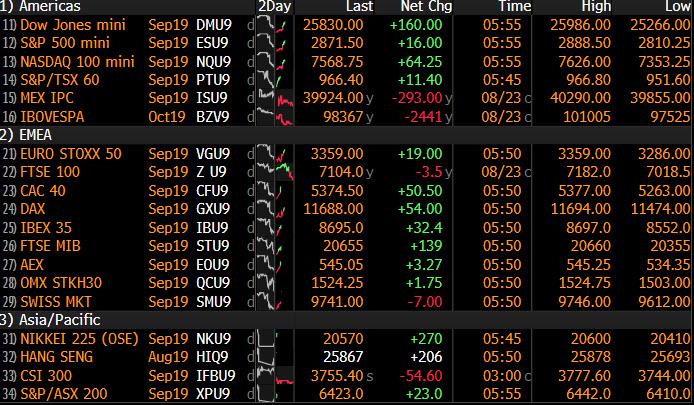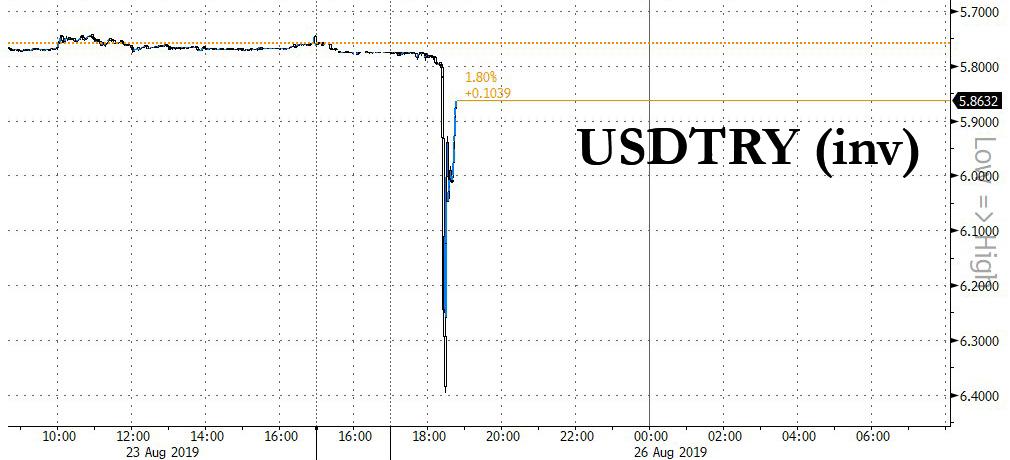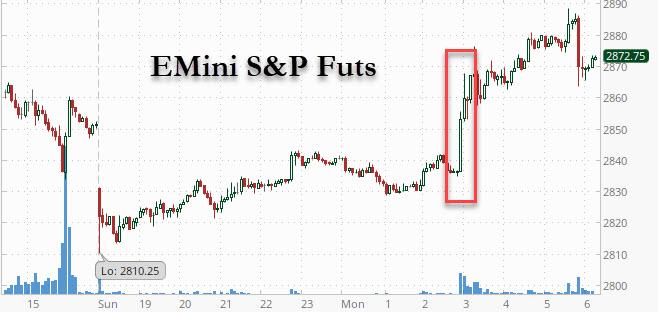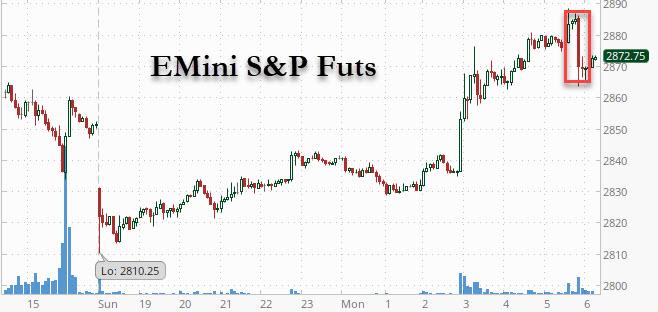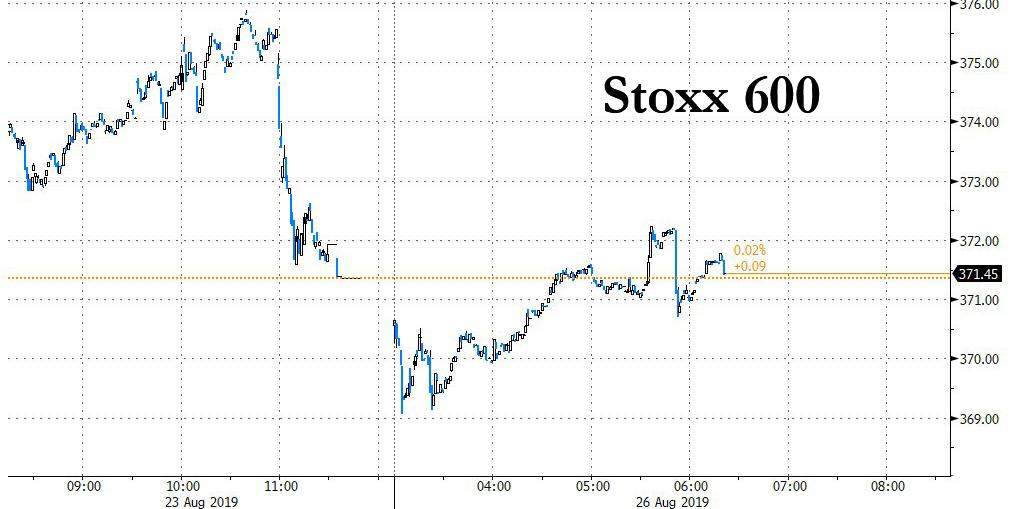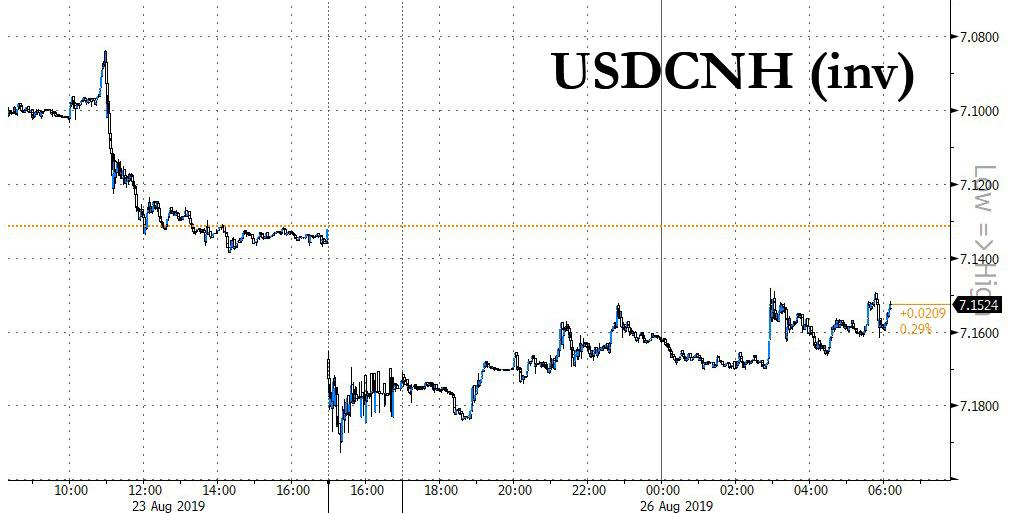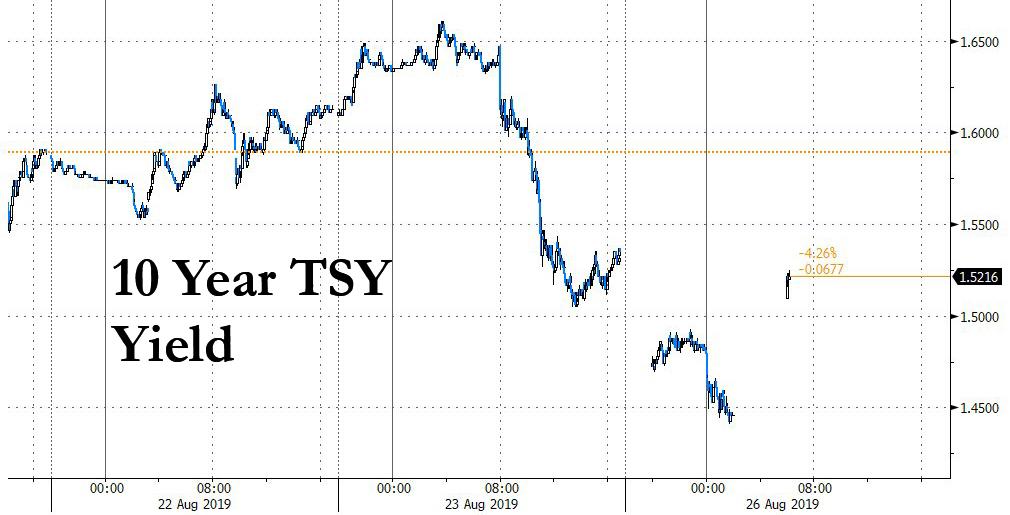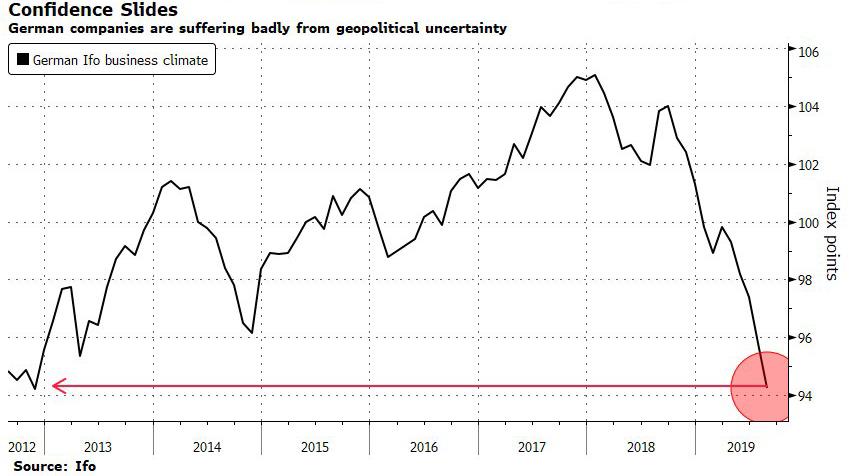US traders went to bed last night with US equity futures down about 30 points from their Friday close. They woke up with the Emini as much as 40 points higher after what has been a surreal night full of apparent lies and panicked attempts to jawbone the market higher.
After a torrid start to the overnight session, which saw US futures tumble, the Chinese Yuan and 10Y Treasury yields all tumble, the safe haven Japanese yen soar and the Turkish lira briefly flash crash as Mrs Watanabe was again stopped out en masse…
… the futures plunge was halted after China’s top trade negotiator, Vice Premier Liu He, had used an appearance in China to call for a de-escalation in tensions.
“We are willing to solve the problem through consultation and cooperation with a calm attitude,” Liu said at the opening ceremony of 2019 Smart China Expo in Chongqing, Caixin reported on Monday. “We firmly oppose the escalation of the trade war,” he said, adding that it “is not conducive to China, the U.S. and the interests of people all over the world.”
Yet while Liu’s comments and a slightly stronger-than-anticipated yuan fixing suggested that traders don’t need to worry about an immediate retaliation from China after a tumultuous weekend – which included China’s flagship People’s Daily reporting that China would follow through with retaliatory measures against Trump’s “barbaric” tariffs and fight the trade war to the end, after the U.S. failed to keep its promises – it was clear that Beijing had no intention of losing face by being the first to make a phone call to Trump in hopes of ending the escalation.
And yet that’s precisely what happened when seconds before the European open, just before 3am ET, speaking at the G-7 Trump said that China wants “to make a deal,” referencing the Liu comments, and saying that Beijing is willing to resolve the ongoing trade war through “calm” negotiations with the United States. And just to make sure that he saves face, Trump also said that US officials received two “very productive” calls from the Chinese but declined to say whether he’d spoken directly to Xi. “They want to make a deal,” he said, adding that the U.S. would accept the Chinese invitation and return to the negotiations. “We’re going to start very shortly and negotiate and see what happens but I think we’re going to make a deal.”
The comment from Trump was enough to send futures surging over 30 points, rising above the Friday close and wiping out all the weekend angst…
… even though moments later, Geng Shuang, a spokesman for the Foreign Ministry in Beijing, said that he wasn’t aware of any weekend U.S.-China phone calls, instead repeating China’s position that the trade war should be settled through negotiation, adding that China resolutely opposes to new US tariffs, and noting that US tariffs violates the accord struck between leaders in Osaka.
Then, just before 6am, China’s Global Times editor in chief Hu Xijin confirmed as much when he tweeted that “based on what he knows”, there were no phone calls between the US and China in recent days, suggesting that Trump may have simply hallucinated the 2 phone calls, which only took place in his head in hopes of keeping stocks from plunging.
Then, in a subsequent tweet, CNBC’s Eamon Javers said
Asked about the Chinese denials of new trade calls, despite President Trump’s statement, Trump implies the calls were with the vice premier of China. Sec. Mnuchin says: “There’s been communication going on.” President Trump chimes in: “at the highest level.” Pressed further about the calls with China that Trump said happened and the Chinese deny, Trump says he doesn’t want to talk about calls.
And the punchline: “Pressed further about the calls with China that Trump said happened and the Chinese deny, Trump says he doesn’t want to talk about calls.”
Pressed further about the calls with China that Trump said happened and the Chinese deny, Trump says he doesn’t want to talk about calls.
— Eamon Javers (@EamonJavers) August 26, 2019
Whather Trump is lying or he thinks he is telling the truth, the rapid reversal in sentiment was enough to send Europe’s Stoxx 600 Index high enough to reverse an earlier loss. German blue chips including Henkel and Siemens have predicted weaker earnings, and the German government has signaled it’s open to fiscal stimulus if the current downturn turns into a severe recession.
Hoping to put lipstick on a pig, Jeferies strategists said that “the Dow lost over 623 points after President Trump’s Tweetstorm last Friday” adding that “by Sunday, President Trump had muddied the waters enough that the escalation may be dismissed as more noise. We also expect President Trump to jawbone the U.S. market higher in coming weeks with spillover effects for China. We continue to believe that all the drama is textbook ‘Art of the Deal’ negotiation style and that some sort of deal is more likely than not.”
Not everyone was as complacent: “The past 72 hours have left financial markets and the global economy in a far more vulnerable position,” said Eleanor Creagh, a strategist in Sydney at Saxo Capital Markets. “As a synchronized global slowdown takes effect and commodity prices roll over there is no reason that bond yields should be heading higher.”
In any case, Trump’s jawboning however came too late to save Asian equities, which dropped, led by communications and technology firms, as investors dumped risk assets and almost all markets in the region were down, with Hong Kong, Taiwan and South Korea leading declines. Japan’s Topix fell 1.8% to a seven-month low, as technology shares weighed heavily on the gauge, even though the U.S. and Japan agreed on a trade deal under which Tokyo would slash tariffs on American farm products, while delaying the threat of additional levies on Japanese auto exports. Over in China, the Shanghai Composite Index retreated 1.2%, driven by China Merchants Bank and Kweichow Moutai; sentiment improved somewhat as China Vice Premier Liu He said the country is willing to resolve the trade dispute with a calm attitude through dialogue, according to a Caixin report.
The yuan plunged to a fresh 11 year low: the offshore yuan weakened for an eighth straight session, dropping as much as 0.9% to the lowest intraday level since it was created in 2010.
With Britain’s market closed for a holiday, Treasuries reopened for trading in the U.S., paring their advance from Asia hours after the 10Y yield plunged to levels just shy of all time lows.
Meanwhile, the euro slumped continued, dropping after German business confidence extended its decline, falling to the weakest level in almost seven years, as a deepening manufacturing slump put Europe’s largest economy on the brink of recession. As a reminder, German GDP contracted in the second quarter and the Bundesbank warned it could shrink again in the third, sending the economy into its first technical recession in years.
Ifo’s business climate index fell to 94.3 in August, missing expectations of a 95.1 print, marking its fifth straight decline. It was weaker than the median estimate in a Bloomberg survey of economists, and gauges for expectations and current conditions also worsened.
“The situation is becoming increasingly dire,” Clemens Fuest, president of the Ifo Institute, said in an interview with Bloomberg Television. “The weakness which was focused on manufacturing is now spreading to other sectors.” Fuest said while industrial woes were originally concentrated in the automotive sector, they’re now reaching chemical and electrical engineering companies, as the manufacturing recession spreads and impacts increasingly more segments of the German economy. Service providers, especially those close to manufacturing such as logistics, are also feeling the pinch.
Elsewhere in FX, the USD/JPY was 0.5% higher at 105.85 after earlier dropping as much as 0.9% to 104.46, surpassing its January flash-crash low and sliding to the weakest since November 2016
As noted above, Treasury futures erased gains, after the 10-year yield fell 9bps to a more than three-year low at 1.44% in Asian trading; following a UK market holiday, the 10Y yield reopened at 1.51%.
Elsewhere, oil futures reversed their earlier declines from Friday, when China announced tariffs on U.S. oil for the first time.
Market Snapshot
- S&P 500 futures up 0.8% to 2,878.25
- STOXX Europe 600 down 0.09% to 371.02
- MXAP down 1.5% to 150.17
- MXAPJ down 1.4% to 484.92
- Nikkei down 2.2% to 20,261.04
- Topix down 1.6% to 1,478.03
- Hang Seng Index down 1.9% to 25,680.33
- Shanghai Composite down 1.2% to 2,863.57
- Sensex up 2% to 37,447.20
- Australia S&P/ASX 200 down 1.3% to 6,440.05
- Kospi down 1.6% to 1,916.31
- German 10Y yield rose 1.6 bps to -0.659%
- Euro down 0.3% to $1.1113
- Italian 10Y yield rose 0.9 bps to 0.969%
- Spanish 10Y yield rose 0.5 bps to 0.143%
- Brent futures up 0.7% to $59.73/bbl
- Gold spot up 0.1% to $1,528.63
- U.S. Dollar Index up 0.3% to 97.93
Top Overnight Headlines from Bloomberg
- U.S. President Donald Trump said China has asked to re-start trade talks, hours after Beijing’s top negotiator publicly called for calm in response to a weekend of tit-for-tat tariff increases that sent global stocks plunging.
- Gold will extend its winning ways as the U.S.-China standoff harms growth, risking a deeper slowdown and inviting more central-bank easing, according to UBS Group AG, which jacked up price forecasts with a prediction the precious metal may hit $1,600 within three months.
- Global banks will this week start making their case on why they should be hired for what’s set to be the world’s biggest initial public offering, according to people with knowledge of the matter.
- UBS Global Wealth Management, which oversees more than $2.48 trillion in invested assets, has gone underweight on equities for the first time since the Eurozone crisis.
- China’s top trade negotiator sought to lower tensions with the U.S. on Monday, saying the dispute between the world’s biggest economies should be resolved through measured dialogue
- Two topWhite House officials said Trump has the authority to force American companies to leave China yet whether he invokes those powers is a another question
- Trump acknowledged having second thoughts on escalating the trade war with China — only for his top spokeswoman to later say he meant he regretted not raising tariffs even more
- Treasury Secretary Steven Mnuchin said Trump’s characterization of the Federal Reserve chief as an “enemy” on par with China’s leader was not meant to be taken literally
- U.S. and Japan agreed in principle on a trade deal that would lower Tokyo’s tariffs on American beef, pork and other agricultural products, while delaying for now the threat of additional levies on Japanese auto exports to the U.S.
- Tensions flared again in Hong Kong as an effort to form a peaceful human chain across the city culminated in police clashes that led to the firing of a weapon and the deployment of water cannons for the first time
- Oil fell for a fourth day as an escalation in the U.S.-China trade war worsened an already shaky global demand outlook.
- Current and former central bankers in Jackson Hole weren’t sure if Mark Carney’s idea for a virtual reserve currency is the answer, but they agree the dollar’s dominance is a problem
Asian equity markets tracked last Friday’s hefty losses on Wall Street and the continued weakness in US index futures at the reopen due to the escalation in the US-China trade war. ASX 200 (-1.2%) was led lower by underperformance in energy after the recent slump in oil and as the tech sector suffered the brunt of the latest trade aggressions, although gold miners bucked the trend after the precious metal surged on a safe-haven bid. Nikkei 225 (-2.2%) was heavily pressured with losses for exporters exacerbated by detrimental currency flows, while Hang Seng (-1.9%) and Shanghai Comp. (-1.2%) slumped amid the trade concerns. Furthermore, Hong Kong was the worst performer amid further unrest as police were said to have beaten protesters and fired tear gas at an anti-surveillance rally over the weekend. Conversely, some of the losses were later pared after China’s Vice Premier Liu He stated that China is willing to resolve the dispute through calm negotiation and resolutely opposes escalation of the trade war, while India markets were intially underpinned after the Finance Minister recently announced several measures to support the economy including a withdrawal of capital gains tax enhanced surcharge and a INR 700bln bank recapitalization but then gradually deteriorated alongside the broad risk averse tone. Finally, 10yr JGBs were underpinned by a safe-haven bid and which coincided with upside in USTs as the US 10yr yield drop to a fresh 3-year low, with the BoJ also present in the market for 10yr+ and inflation indexed bonds.
Top Asian News
- Hong Kong Stocks Slump, Yuan Slides to 11-Year Low on Trade War
- Bankers Head to Saudi Arabia to Compete for World’s Biggest IPO
- Lira’s Crash Stuns Japan’s Mom-and-Pop Investors Again
- Vietnam Prefers Its Mobile Networks to Be Free of Huawei
European equities are higher across the board [Eurostoxx 50 +0.6%] after US President Trump adopted a constructive tone regarding talks with China, whilst upside in the region was exacerbated after the US President stated the US and Germany have reached agreements on a number of subjects including trade, whilst also noting that US and France are getting close to a compromise on the digital tax issue. However, bourses came off highs after China Global Times editor noted that US and Chinese negotiators did not hold a phone call. Nonetheless, stocks are still supported by hopes of potential tariffs delays on China. Sectors are mixed with no clear winner/laggard. In terms of individual movers, UBS (-1.4%) shares fell after source reports that the bank reportedly explored an alliance with Deutsche Bank (+0.3%). Meanwhile, EssilorLuxoticca (+1.2%) shares spiked higher amid reports that ThirdPoint LLC have acquired a stake in the Co. Note, the FTSE is closed due to UK Summer Bank Holiday today.
Top European News
- German Business Confidence Worsens as Recession Risks Increase
- EssilorLuxottica Gains on Report Dan Loeb Is Building Stake
- Weak Koruna Means Czech Rate Stability Through 2020 for Nidetzky
In FX, the major safe-havens – JPY/CHF/XAU – have retreated from lofty overnight peaks amidst comments from US President Trump at the G7 about conversations between Chinese and US officials following Friday’s reciprocal ramp up of tariffs that could bring the 2 sides back to the negotiating table. Even though China’s Foreign Ministry is unaware of any such calls, the markets are waiting for a statement from Trump with risk aversion receding in the run up. Hence, Usd/Jpy, Usd/Chf and Xau/Usd are extending their retracement to circa 106.00, 0.9785 and 1525/oz from just shy of 104.50, 0.9710 and 1555 respectively at one stage, to the benefit of the DXY that is rebounding towards 98.000 vs 97.618 at the low.
- GBP/NZD/EUR/CAD – All on the defensive as the Greenback broadly recovers as noted above, but with Sterling also losing more of its Brexit positivity after UK PM Johnson cautioned that while prospects of reaching a deal have improved it remains a close call. Cable is back down around 1.2235 compared to 1.2285 at best, which coincided with a Fib retracement and resistance level ahead of 1.2300 as well, while Nzd/Usd remains toppy on approaches to 0.6400 and is still underperforming vs the AUD as the cross rebounds to 1.0600 and Aussie derives more traction from the latest Trump tweets within a 0.6765-0.6690 range. Note also, the Kiwi was not helped by NZ trade data showing a deficit as imports eclipsed exports in July. Elsewhere, the Euro is slipping back towards 1.1100 from 1.1165 with additional pressure, albeit incremental, coming via a dire German Ifo survey and the institute clarifying that the declines in business sentiment, current conditions and expectations did not take into account latest trade war escalations, though this is hardly surprising given the timing of the August poll. Last but not least, the Loonie is still pivoting 1.3300 and not gleaning any independent impetus from Canadian data, but US durable goods may impact as the series of often erratic.
- EM – Some calm after the overnight risk-off storm, and especially for the Turkish Lira that suffered losses in keeping with a flash crash when Japanese margin accounts are said to have liquidated unprofitable long Try/Yen positions. Usd/Try is back down near 5.8200 compared to almost 6.3000 during Asian trade, but Usd/Cny remains relatively bid above 7.1500 irrespective of more conciliatory remarks from Trump who is not ruling out another roll-back of Chinese tariffs, and reports of big Chinese banks selling Dollars vs the Yuan.
In commodities, WTI and Brent futures are marginally in positive territory as the benchmarks ride on the current “risk on” wave in the markets after US President Trump took a constructive stance regarding US-Sino trade dialogue, ahead of an announcement on China later today; however recent comments from China’s Global Times Editor have paired back much of this positivity. WTI futures have just climbed above the 54.50/bbl level whilst its Brent counterpart eyes 60/bbl to the upside. In terms of geopolitics, Iranian Foreign minister Zarif unexpectedly attended side-line discussions at the G7 summit. It is unclear if the brief meeting between Macron and Zarif yielded any significant progress as US President Trump has since declined to comment on whether oil sanctions would be waived to have Iran return to the negotiating table; though they are going to discuss ballistic missiles and the duration of any subsequent agreement with Iran. Participants will today be eyeing trade developments as a catalyst, with US President Trump set to make an announcement later today, although no specific time was mentioned. In terms of US President Trump’s scheduling for the day, aside from the scheduled G7 pressers, he is to hold a press conference with French President Macron at 14:30BST. Elsewhere, gold prices have retreated after printing fresh 6-year highs on the back of trade developments, which saw the precious metal soar above 1550/oz early Asia-Pac trade. Meanwhile, copper prices saw a firm rebound after briefly breaching 2.5/lb to the downside. Finally, Dalian iron ore prices saw renewed downside amid President Trump’s announcement on Friday that tariffs on China (current and impending) will be raised by 5ppts.
US Event Calendar
- 8:30am: Chicago Fed Nat Activity Index, est. 0, prior 0
- 8:30am: Durable Goods Orders, est. 1.2%, prior 1.9%; Durables Ex Transportation, est. 0.0%, prior 1.0%
- 8:30am: Cap Goods Orders Nondef Ex Air, est. 0.0%, prior 1.5%; Cap Goods Ship Nondef Ex Air, est. 0.1%, prior 0.3%
- 10:30am: Dallas Fed Manf. Activity, est. -4, prior -6.3
DB’s Jim Reid concludes the overnight wrap
Before we turn to the week ahead, it’s worth recapping the trade war news which sent the S&P 500 to -2.58% loss yesterday. It’s now -5.89% off its recent all-time high. The index had dipped -0.73% in early trading after China announced new retaliatory tariffs on the US, but then clawed back into positive territory after Fed Chair Powell delivered a somewhat dovish speech at Jackson Hole. Equities then tumbled after President Trump’s tweets, where he promised to announce higher tariffs. After markets had closed, Trump did announce a tax rate hike on the already-tariffed Chinese goods, from 25% to 30%, and from 10% to 15% for the goods set to be tariffed this fall and winter.
In line with the seasonal trend, the calendar for next week is light. The biggest event could end up being the USTR’s decision regarding potential retaliation against France for its planned digital services tax. The comment period ends on Monday and the USTR could take action at any point thereafter. With the US-China trade war at a near-boiling point, there is a risk that the US opens another front, this time against Europe. Higher tariffs or tougher sanctions would obviously not be positive for near-term growth. There is also the risk of negative trade headlines at the G7 leaders’ summit, taking place today through Monday in France.
As for this week’s data calendar, there are a slew of lower-tier releases scheduled. In Europe, we’ll get Germany’s IFO survey on Monday, followed by the final print of GDP on Tuesday, where consensus expectations are for no change to the -0.1% qoq print. Then we’ll have German and Spanish CPI on Thursday, followed by the France, Italy, and the broader euro area on Friday The core measure for the broad euro area is forecast to firm slightly to 1.0% yoy, up 0.1pp from July, though the headline is expected to decline 0.1pp to 1.0%.
In the US, we’ll get durable and capital goods orders on Monday, which are expected to moderate a touch from June’s strong prints, followed by surveys from the Chicago and Dallas fed banks on Monday and from the Richmond fed on Tuesday. Those surveys are expected to firm a touch but remain in contractionary territory. The second reading of US GDP is due on Thursday, where the consensus is for a 0.1pp downward revision to 2.0% annualized growth. Finally, core PCE is due on Friday where our economists expect a print of 1.6%, in line with consensus. However, they do highlight that given the recent CPI and PPI data, there’s a risk that reading slides to 1.5%, well below the Fed’s 2% target.
Now back to the substance of the market-shaking events on Friday. First, China announced retaliatory tariffs of 5-10% on $75bn of imports from the US. The new measures will take effect either on 1 September or 15 December, depending on the product, mirroring the recently-announced US tariffs on China. That news sent S&P 500 futures down as much as -1.00%, and also sent the STOXX 600 instinctively down -0.74%.
Risk assets stabilized, however, after Chair Powell delivered somewhat dovish remarks, which also send bond yields a few basis points lower. He mentioned “significant risks” from slower global growth, trade policy uncertainty, and muted inflation. Powell went on to note that there is evidence that r* is lower than previously thought, and “a lower r* combined with low inflation means that interest rates will run, on average, significantly closer to their effective lower bound.” Those comments, plus his notable omission of the phrase “mid-cycle adjustment” sent the signal that the Fed is prepared to cut rates more aggressively than perhaps feared before. The initial market response was positive, with front-end yields falling and equities rallying.
However, by far the biggest market-moving event on Friday was President Trump’s tweets against China. First, he tweeted “who is our bigger enemy, Jay Powell or Chairman Xi?” followed by “our Intellectual Property at a rate of Hundreds of Billions of Dollars a year” and said that the US “would be far better off without” China. He then said that “our great American companies are hereby ordered to immediately start looking for an alternative to China” and promised to respond to China’s tariffs. Those comments indicated that the trade war is unlikely to moderate in the near-term, which sent stocks and bond yields lower. The dollar, which has tended to rally on new tariff announcements, instead dropped against major partners. That could reflect fears that Trump will try to intervene to weaken the dollar directly, or it could be more positioning-driven.
As mentioned at the top, President Trump then announced a hike in rates across the suite of tariffs on China. The rates will rise from 25% to 30% on the list of around $250 billion of goods already being taxed, and from 10% to 15% for the list of around $300 billion of goods due to be tariffed from 1 September and 15 December. The overall size of President Trump’s tariffs is now up 0.6% of GDP, a fairly sizeable figure, especially when headline growth has been running around 2.0%.
Now to quickly recap markets in more detail, with the sharp drop in US equities on Friday undoubtedly the main talking point. The S&P 500 retreated -2.58% on Friday and -1.42% on the week. That marks the fourth consecutive weekly decline for the index. The NASDAQ and DOW saw similar moves, ending the week -1.83% and 0.99% (-3.00% and -2.37% Friday) respectively. The most trade-exposed sectors suffered most, with semiconductors retreated -2.22% (-4.36% Friday). Equities in Europe ended lower, but they had closed before the selling in the US accelerated. The STOXX 600 ended the week +0.47% (-0.78% Friday). HY cash spreads were -13.4bps tighter in the US (+15.3bps Friday) and -32.2 bps tighter in Europe (-6.2bps Friday).
Bonds mostly strengthened on the week, with ten-year treasury yields declining -2.9bps (-8.8bps Friday) and the 2y10y yield curve declining -7.4bps back to -0.02bps, just barely inverted (+0.1bp Friday). That curve measure did close at an inverted level earlier on Thursday however, its first sub-zero close since 2007. German bunds ended +1.0bps higher (-3.1bps Friday) while BTPs rallied -7.8bps (+1.0bp Friday). The dollar weakened -0.44% (-0.47% Friday) and the euro strengthened a similar amount, up +0.41% on the week (+0.51% Friday). The offshore Chinese yuan weakened -1.28% (-0.65% Friday) to 7.13, while the onshore yuan depreciated -0.74% (-0.17% Friday) to 7.0955, its weakest level since March 2008.
via ZeroHedge News https://ift.tt/2ZkPpqj Tyler Durden
